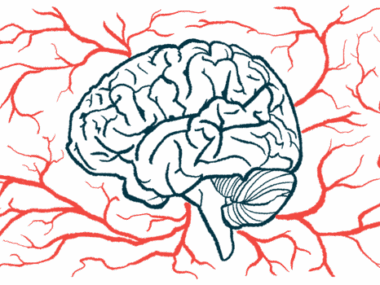Key to Unlocking Blood-brain Barrier Discovered in Mouse Study
Written by |

A team of researchers has discovered that the key to bypassing the blood-brain barrier — a semipermeable border that protects the brain against toxins in the blood but also blocks potential treatments — is the Unc5B receptor in the endothelial cells that line the tiny blood vessels in the brain.
Blocking Netrin-1, a protein that interacts with Unc5B, broke down the barrier on-demand, the scientists found — a discovery that may open the door to the development of therapies that directly target nerve fiber damage in people with multiple sclerosis (MS).
“This is the first time we’ve figured out how to control the blood-brain barrier with a molecule,” Anne Eichmann, PhD, the study’s senior author, said in a press release.
The study, “Endothelial Unc5B controls blood-brain barrier integrity,” was published in the journal Nature Communications.
In MS, an altered inflammatory response damages the myelin sheath that surrounds and protects nerve fibers in the brain and spinal cord.
The two main MS treatment approaches are immunomodulatory therapies to control inflammation and help restore nerve function, and supportive medicines that ease symptoms and treat acute flare-ups.
One of the major impediments to further therapeutic development is the limited access to the brain caused by the blood-brain barrier (BBB). That highly selective membrane protects the brain and spinal cord, collectively known as the central nervous system (CNS), from harmful organisms and other damaging substances carried in the blood.
When it comes to treating the brain directly in MS and other neurological diseases, however, the barrier “becomes your worst enemy,” said Eichmann, ensign professor of medicine and professor of cellular and molecular physiology at Yale University School of Medicine, in Connecticut.
The BBB is formed by specialized endothelial cells that line the tiny blood vessels in the brain. Unlike other blood vessels in the body, these specialized cells form tight junctions with each other to prevent substances from crossing from the bloodstream into the brain, and tightly regulating which molecules can pass through.
Understanding how these endothelial cells in the brain function may pave the way to control the BBB and the development of MS therapies that can be delivered directly to the brain.
First author Kevin Boyé, PhD, a postdoctoral associate at Yale, was the first to investigate Unc5B, a protein receptor found on the membrane of endothelial cells lining tiny blood vessels in the brain.
In his first experiments, Boyé deleted the gene encoding Unc5B specifically in endothelial cells of newborn mice, but they died around 12 days after birth. Further tests showed a dye injected into the bloodstream leaked into the brain, “confirming that Unc5B deletion impaired BBB development.”
The gene was then deleted from adult two-month-old mice, and similarly, the dye leaked into various brain regions.
To determine the cause of the BBB defect, the team measured the production of proteins known to participate in barrier function. Mice lacking Unc5B had a significant reduction in the levels of the protein Claudin-5, alongside an increase in PLVAP. Claudin-5 is a component of the tight junctions found on specialized endothelial cells in the brain, while PLVAP increases endothelial cell permeability, or their ability to let molecules pass through.
Because the production of Claudin-5 and PLVAP is controlled by a signaling pathway called Wnt, its connection between Unc5B was then investigated. In the absence of Unc5B, the Wnt pathway was “dramatically downregulated,” the team wrote.
Normally, activation of the Wnt pathway leads to an increase in a protein called beta-catenin protein, which then travels to the nucleus where a cell’s genetic information is stored, to activate barrier-related genes. Mice lacking Unc5B, bred to generate excess beta-catenin, showed an increased production of Claudin-5, reduced PLVAP, and suppressed dye leakage into the brain, “suggesting that Unc5B acted upstream of Wnt signaling,” the researchers wrote.
Next, the team deleted a gene that encodes the protein Netrin-1, which is known to bind directly to Unc5B. These mice showed increased dye leakage across the BBB, reduced production of Claudin-5, and an increase in PLVAP.
These results were confirmed when the team injected healthy mice with an antibody designed to block Netrin-1, which led to increased dye leakage into the brain, “demonstrating that blocking Netrin-1 binding to Unc5B is sufficient to open the BBB,” the scientists wrote.
“It was quite a fascinating journey, especially the development of our blocking antibodies and seeing that we can open the blood-brain barrier in a very time-sensitive fashion to promote drug delivery,” said Boyé.
Lastly, the team found that dye molecules up to the size of a medium-sized protein, or 40 kilodaltons, were able to pass through the barrier in mice lacking Unc5B or in those treated with anti-Netrin-1 antibodies. Conversely, larger dye molecules or large proteins like antibodies and blood clotting fibrinogen, did not pass.
“These data identify Netrin-1-Unc5B signaling as a ligand-receptor pathway that regulates BBB integrity, with implications for CNS diseases,” the reseachers wrote.
“This paves the way to more interesting basic research around how the body builds such a tight barrier to protect its neurons and how can it be manipulated for drug delivery purposes,” said Eichmann. “And then there’s also potential to use this as a delivery platform for drugs to penetrate into the brain.”






